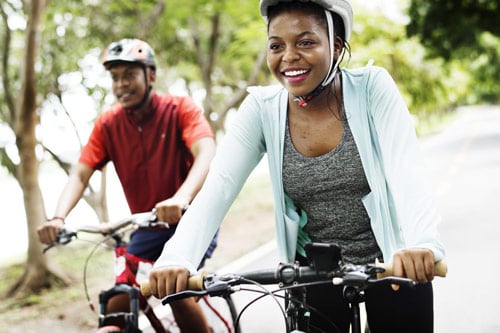Promote Active Transportation
Active transportation systems connect the places where people live, learn, work, shop, and play by providing safe and convenient walking and bicycling facilities. The safety of all road users can increase as more people choose active transportation.
Recommendations

- Promote safe and convenient opportunities for physical activity by supporting active transportation infrastructure, such as:
- Well-lit sidewalks, shared-use paths, and recreational trails.
- Safe roadway crossings.
- Creation of bicycle-supporting infrastructure including shared-use paths and interventions that reduce motor vehicle traffic and vehicle speed on neighborhood streets, such as bicycle boulevards.
- Safe pedestrian and bicycling connections to public transportation.
- Safe and convenient pedestrian and bicycling connections to public park and recreation areas.
- Increase opportunities for physical activity by devoting increased resources to non-motorized transportation options.
- Consider incentives for states and regions that reduce vehicle miles traveled per capita and implement active living environments that promote walking and bicycling, using public transportation, and reducing air pollution (including greenhouse gas emissions).
- Provide states with tools necessary to evaluate and effectively increase investments in bicycle and pedestrian infrastructure and programming. Activities to be evaluated could include:
- Comprehensive street design measures, such as Complete Streets, which provide safe and convenient travel for all users of the street. Examples include expanding space for bicycle lanes and sidewalks, placing bus stops in safe and convenient locations, and making improvements accessible for disabled users.
- Complementary systems of shared-use paths connected to roadways that provide safe places to walk and bicycle for children, the elderly, and the general public.
- Bicycle-supporting infrastructure including shared use paths and interventions that reduce motor vehicle traffic and speed on neighborhood streets to provide direct, safe routes for bicyclists.
- Safe Routes to School initiatives including the development of sidewalks, shared-use paths, and bicycle infrastructure to ensure that children can walk and bicycle safely to school. Support activities include education, encouragement, enforcement, and evaluation.
- Bring health, transportation, and community planners together to develop safe, convenient, and complete pedestrian and bicycle master plans, including an inventory of current sidewalks, bicycle facilities, recreational trails, and shared-use paths, which can be incorporated into city general plans and capital improvement programs.
- Work with state and local transportation and planning officials to integrate and enforce use of pedestrian and bicycle design guidelines and evidence-based safety standards into transportation planning practice and support evaluation of innovative designs.
- Bring together specialists in transportation, energy, community planning and health to establish federally recommended guidelines for the inclusion of active transportation infrastructure in building and development efforts.
- Explore opportunities for increasing availability of funds for establishing active transportation initiatives.
Error processing SSI file
